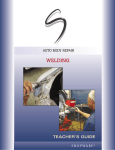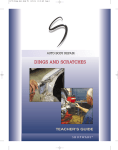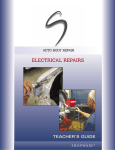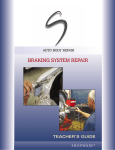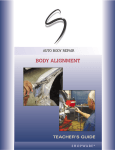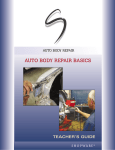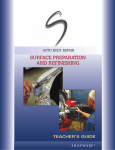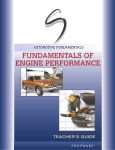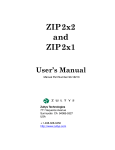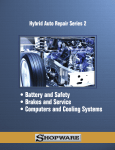Download 32777 Welding Auto Body Tg
Transcript
AUTO BODY REPAIR WELDING TEACHER’S GUIDE S H O P WA R E ® INTRODUCTION This Teacher’s Guide provides information to help you get the most out of Welding. The contents in this guide will enable you to prepare your students before using the program and present follow-up activities to reinforce the program’s key learning points. As part of the 12-part series Auto Body Repair, Welding introduces basic welding concepts related to collision repair, including different types of fusion welding, the setup and functionality of the welding gun, types of weld joints and how to make and test them, and safety precautions to practice when welding. After viewing this video, students will have a more detailed understanding of welding equipment and techniques used in collision repair, and safety precautions to take when performing welding tasks. Use the Welding video and accompanying activities provided in this guide to teach students basic welding techniques, setting up the welding gun and metal assemblies prior to welding, and welding safety practices. LEARNING OBJECTIVES After viewing the program, students will be able to: ■ Identify different types of welds. ■ Explain MIG Welding techniques. ■ List considerations for planning a weld. ■ Identify the correct tools to use given the task to be performed. ■ Demonstrate a basic knowledge of welding operations and safety procedures. ■ Summarize proper preparations for welding. EDUCATIONAL STANDARDS The primary certifying body for automotive technician training programs is the National Institute for Automotive Service Excellence (ASE). ASE is a non-profit organization established in 1972 by the automotive industry to improve the quality of vehicle repair and service through the voluntary testing and certification of automotive repair technicians. The National Automotive Technicians Education Foundation (NATEF) is a separate non-profit foundation within ASE. The mission of NATEF is to improve the quality of automotive technician training programs nationwide through voluntary certification. The State Departments of Education in all 50 states support ASE/NATEF certification of automotive programs. National Standards This program correlates with the Program Certification Standards for Automobile Technician Training Programs from the National Institute for Automotive Service Excellence (ASE) and the National Automotive Technicians Education Foundation (NATEF). The content has been aligned with the following educational standards, which reflect the tasks in the ASE Program Certification Standards for Automobile General Service Technician Programs. Copyright © 2005 SHOPWAR E ® 2 Metal Welding ■ Determine correct welding process in accordance with vehicle manufacturer’s / industry’s recommendations (GMAW [MIG], squeeze-type resistance spot), electrode, wire type, diameter, and gas to be used in specific welding situations. ■ Set up and adjust welding equipment for the material to be welded (steel, aluminum). ■ Determine proper welding technique (push, pull, and gun angle) for the type of welds being made. ■ Identify the type of weld joint (butt, lap, etc.) for the repair being made. ■ Use the proper gun-to-joint angle, and direction of gun travel, for welds being made in all positions. ■ Determine the correct type of weld (continuous, stitch, skip, plug, spot, etc.) and preparation for each specific welding operation. ■ Identify the causes of welding defects (burn through, cracks in metal, porosity, improper penetration, excessive splatter, distortion, and waviness of bead,); make necessary adjustments. ■ Insure proper work clamp (ground) location. ■ Prepare the metal to be welded; assure good metal fit-up; apply weld-through primer, if necessary. ■ Perform test welds. Visually inspect and perform destructive test. ■ Protect vehicle systems and components, including computers, other electronic modules, adjacent panel and glass from possible damage during welding and cutting operations. ■ Identify safety considerations: Eye protection, proper clothing, respiratory protection, shock hazards, fumes, material safety data sheet (MSDS), etc. before beginning any welding operation. 2004 Automobile Program Standards, by the National Institute for Automotive Service Excellence (ASE), Copyright 2004 Reprinted with permission. Language Arts and Communication Standards According to ASE/NATEF standards, the automobile technician must be proficient in the following Language Arts and Communications related academic skills that are embedded in the occupation. The activities and information presented in this program and accompanying teacher’s guide are aligned to the following standards from the National Automotive Technicians Education Foundation from the National Institute for Automotive Service Excellence. ■ Request, collect, comprehend, evaluate, and apply oral and written information gathered from customers, associates, and supervisors regarding problem symptoms and potential solutions to problems. ■ Identify the purpose for all written and oral communication and then choose the most effective strategies for listening, reading, speaking, and writing to facilitate the communication process. ■ Adapt a reading strategy for all written materials, e.g. customer’s notes, service manuals, shop manuals, technical bulletins, etc., relevant to problem identification, diagnosis, solution, and repair. ■ Use study habits and techniques, i.e. previewing, scanning, skimming, taking notes, etc., when reviewing publications (shop manuals, references, databases, operator’s manuals, and text resources) for problem solving, diagnosis, and repair. 3 ■ Write clear, concise, complete, and grammatically accurate sentences and paragraphs. ■ Write warranty reports and work orders to include information regarding problem resolution and the results of the work performed for the customer or manufacturer. ■ Follow all oral/written directions that relate to the task or system under study. ■ Comprehend and apply industry definitions and specifications to diagnose and solve problems in all automotive systems and components of the automobile and light truck. ■ Comprehend and use problem-solving techniques and decision trees that are contained in service manuals and databases to determine cause-and-effect relationships. ■ Use the service manual to identify the manufacturer’s specifications for system parameters, operation, and potential malfunctions. ■ Supply clarifying information to customers, associates, parts supplier, and supervisors. Technology Standards The activities in this Teacher’s Guide were created in compliance with the following National Education Technology Standards from the National Education Technology Standards Project. The content has been aligned with the following educational standards and benchmarks. ■ Use a variety of media and formats to communicate information and ideas effectively to multiple audiences. ■ Use telecommunications to collaborate, publish, and interact with peers, experts, and other audiences. ■ Use productivity tools to collaborate in constructing technology-enhanced models, prepare publications, and produce other creative works. ■ Use technology tools to enhance learning, increase productivity, and promote creativity. ■ Use technology to locate, evaluate, and collect information from a variety of sources. The National Education Technology Standards reprinted with permission from the International Society for Technology Education. PROGRAM OVERVIEW The ability and knowledge to weld properly is one of the most useful skills an auto body technician can master. A top quality weld is the foundation of professional collision repair. This video, Welding, offers a behind-the-scenes look at the welding process in a collision repair facility. Viewers will closely examine the functionality of the various parts of the MIG welding gun, the most commonly used welding gun for auto body repair today, and the method to set up the equipment prior to use. The different types of collision repair welding techniques and weld joints will be explored, including when to use them, potential problems, and quality testing. Viewers will also learn important safety precautions to practice in order to protect their body and surrounding property when performing welding tasks. 4 MAIN TOPICS Topic 1: Types of Fusion Welding This section of the program introduces the concept of welding, and the different types of fusion welding, including their suitability for collision repair. Topic 2: MIG Welder Setup and Functionality This section of the program describes how to set up a MIG (metal inert gas) welder, the type of welder most often used in auto body repair, and how it works. Students will learn the primary parts of the welder and the function of each component, and the ways in which travel speed, direction, and gun angle affect the quality of a weld. Topic 3: Types of Weld Joints and Welding Techniques This section of the program describes types of weld joints and how to form them using the welding gun. Students will learn the factors that determine when to use each type of weld joint. Topic 4: Practice Welds and Destructive Testing This section of the program describes the importance of practicing welding techniques and the destructive testing method used to determine the quality of the weld. Topic 5: Safety Practices In this section, students will learn the significance of protective clothing, and the necessary precautions to take when performing welding tasks to avoid bodily injury and damage to nearby property. FAST FACTS ■ Welding is a process where heat is applied to two pieces of metal to fuse them together. In many cases, additional filler material from a wire or rod is added to help complete the weld joint. ■ Most of today’s vehicle frames are built in one piece, called a unibody, which is constructed by welding, bolting, and adhesive-bonding the various body parts together. ■ MIG welding is the ideal welding process for collision repairs because it concentrates the heat in a narrow area; the welds performed on unibody frames during collision repairs must achieve100 percent fusion in order to maintain their structural strength. ■ When the welding gun trigger is pressed, an electrical current passes from the contact tube to the automatically-fed electrode wire, creating a small arc between the wire and the layers of base metal to be welded. The heat from the arc melts the wire and fuses it together with the layers of base metal, while flowing shielding gas isolates the weld from contaminants in the air. Once it cools the wire and base metals are completely fused together at the joint, creating one solid piece of metal. ■ .023 [Oh-two-three] wire, a special wire used for auto body repair, is made of a highgrade steel alloy that has a tensile strength of 70,000 pounds. As it melts, it helps fill in the joint, adding strength to the weld. 5 ■ To set up the MIG welder, reference the operating manual to: (1) set up the wire feed mechanism for .023 wire; (2) hook the gas supply to the welder; (3) set the gas regulator on the gas supply to control speed of the gas flow for 0-2-3 wire; (4) set the amperage (heat and voltage) and wire speed for 0-2-3 wire; (5) choose the polarity (direction of current); and (6) plug the welder into a 110 or 220 grounded outlet. ■ Variables that affect the quality of a weld are travel speed, travel direction, and gun angle. ■ The seven basic types of weld joints are tack, spot, plug, butt, reinforced butt, lap, and a fillet weld. ■ The type of weld to use is determined by the location of the joint on the vehicle and whether the repair area is structural or non-structural. ■ The steps to prepare for a weld are: (1) prepare the surface by removing paint, undercoatings, rust, dirt, oil and grease; (2) apply a weld-through primer to the surfaces to be welded and areas immediately adjacent to protect against corrosion in weld zones; and (3) chemically clean the area to be welded. ■ Since MIG welders reach a temperature approaching 9,000 degrees Fahrenheit and produce ultraviolet light (the same light that causes sunburn), proper protection is critical! ■ Proper safety clothing and equipment include a welding hood with #10 shade to protect against blinding light; leather gloves to protect against metal cuts and sparks; non-flammable long sleeves and pants without cuffs that can trap sparks (jumpsuit preferred); leather vests for welding overhead; and work boots. ■ Practice safety in the shop by covering adjacent equipment and car parts to protect property from flying sparks. ■ Practice safe MIG welder operation by avoiding wet floors; checking fraying on cords/cables; keeping the welder within reasonable distance of the welding site; and ensuring the MIG set up follows all operator manual specifications. ■ The grounding cable from the welder must be clamped to bare metal on the same panel that is being welded as close as possible to the weld point to complete the electrical circuit for the welder and enable the current to flow. ■ Apprentice welders should practice making weld joints and then destroying them. Destructive testing is intended to determine the strength and penetration of the weld to see if it was done correctly. A good weld joint is one that tears apart when destroyed; a weak weld joint is one that simply breaks apart with little or no tearing. VOCABULARY TERMS amperage: The voltage on the MIG welder that typically uses the wire feed speed to control the amount of heat at the arc. Since the heat remains relatively constant, the weld beads produced are usually uniform in shape and size. “Current” is another name for amperage. argon gas: An inert gas found in shielding gas used in MIG welding that protects the weld from contaminants. Typically combines with the steel in the joint and makes a stronger, cleaner weld. burn-through: A condition that occurs when the welding gun is moved too slowly or held in place for too long, causing the weld bead to melt too far down into the joint and burn through the other side of a steel panel, which reduces the strength of the weld joint. (The slower the weld gun is moved, the deeper the weld penetration.) 6 butt weld: A type of weld that is used to join two metal parts aligned in the same plane (butting up against one another) by filling the gap between the two metal parts. contact tube: A tube on a welding gun, usually made of copper or copper alloy that conducts electricity. direct current: An electrical current that flows in one direction only. electrode wire: Part of the welding gun that must be in contact with the base metal to complete the electrical circuit and start the welding process. fillet weld: A type of weld that joins two pieces at right angles to one another with a continuous weld bead or with spot welds. full penetration: A condition that occurs when the MIG welding gun is held in place just long enough, causing the weld fusion to penetrate through the full thickness of the base metal, but not so far as to burn through the other side. Typically characterized by a low profile weld bead. fusion: Heating materials to be joined to their melting point, so that the molecules of the metals actually combine. gas nozzle: A component that fits on the tip of the welding gun, which directs the flow of shielding gas to the weld. gas regulator: Component on the gas supply that controls the speed of the shielding gas flow in MIG welding. inert: Not combining readily with other elements; a property of argon gas. lap weld: A type of weld that is formed when two pieces of metal overlap and are welded together, front and back, by running a continuous weld bead or spot welds along the joints. stitch a weld: A technique used to prevent metal from overheating by pausing between welds to allow the metal to cool. metal inert gas (MIG) welding: (Also called “gas metal arc welding” or “wire-feed welding”). A type of gas metal arc welding process that automatically feeds wire (the metal) through the welding tip into the weld while using shielding gases to protect the metal against corrosion during the welding process. MIG welding is ideal for collision repair on high strength steel because it happens in a microsecond, preventing the metal surrounding the weld joint from heating up, and because it achieves 100 percent fusion. Can be used to weld metals other than steel, such as aluminum, but requires different wire, shielding gas, and settings. .023 (oh-two-three) wire: A type of special wire that is made of a high-grade steel alloy that has a tensile strength of 70,000 pounds. As it melts, it helps fill in the joint, adding strength to the weld. .023 wire can be used on all thicknesses of steel during auto body repairs. oxyacetylene welding: A fusion welding process which uses a mixture of oxygen and acetylene gas that is slow to reach the melting temperature of steel, but heats up the metal in areas adjacent to the weld, causing warping and loss of structural strength. For this reason, it is no longer recommended for most collision repairs, but can be used for metal cutting, fastener removal, and heat cleaning. plug weld: A type of weld that is used to weld two or more base metals together by drilling small holes (8 millimeters to >1/4 inch) that get progressively smaller, and filling them with short bursts from the outside working inward to ensure fusion of each layer. polarity: The direction of the flow of current in a circuit. In collision repair, reverse polarity or direct current (DC) reverse is typically used because it provides the best fusion, due to a more stable arc. 7 pulling the weld: A welding technique where the tip of the weld gun is angled toward the weld puddle as the gun is moved along the seam being welded. Pulling the weld requires a slower travel speed than pushing. pushing the weld: A welding technique where the tip of the weld gun is angled away from the weld puddle as the gun is moved along the seam being welded. Pushing the weld requires a faster travel speed than pulling, and is more prone to burn-through. reinforced butt weld: A variation of a butt weld that is formed by inserting another piece of metal (same as that being welded) behind the joint and running a continuous weld joint down the face of the joint, fusing the insert to the other panels. resistance spot welding (pressure welding): A welding process that heats metal by an electric current passing through the arms of the welder until the metal is softened, and then fuses the metal pieces together using the two metal arms to apply pressure to both sides of the metal panels being welded. Typical characteristics are small, round weld beads. Most often used during the vehicle manufacturing process; less commonly used in collision repair due to restricted access to both sides of the panels being welded. shallow penetration: A condition that occurs when the MIG welding gun is removed too quickly from the weld panel. There is virtually no weld bead. After grinding off the weld bead, there is little left to hold these two pieces of material together, resulting in a weak weld. shielding gas: A type of gas that flows through a MIG weld gun tip during the welding process that isolates the weld from contaminants in the general atmosphere. C-25 shielding gas is a 75-25 mixture of argon and carbon dioxide that is typically used in MIG welding. simple butt weld: A variation of a butt weld that is formed by holding the weld gun at a 90 degree angle and moving it along the joint to create one continuous weld. Is most often used in areas that do not require structural strength (sectioning repairs on rocker panels and door posts). spot weld: A type of weld that is used to fuse the top metal to the bottom without pre-drilling a hole. A spot weld is made by holding the welding gun at a 90-degree angle from the base metals to be welded. This weld type is not strong or consistent. tack weld: A type of weld that uses small weld beads to hold the pieces of metal in proper alignment temporarily until the final welds are made. Enables the welder to determine if all pieces fit, tungsten inert gas (TIG) welding: A type of gas metal arc welding process that is often used in engine repair. weld bead: A weld deposit produced by a single pass during one of the welding processes. weld joint: The joining of two or more metal parts by welding. welding: A process of applying heat to two pieces of metal to fuse them together. Often, additional filler material from a wire or rod is added to help complete the weld joint. weld puddle: The accumulation of molten welding metal within a weld joint. 8 PRE-PROGRAM DISCUSSION QUESTIONS 1. What is welding? Why is it used? And what does it accomplish? 2. Have you seen someone weld something—either in person or on television? If so, what were they welding? What type of tools and equipment were they using? 3. Many of the things we use in our daily lives are welded or made with welding equipment. What are some everyday items or structures that are constructed using a welding process? 4. What welding equipment is used when performing collision repairs? 5. Safety is important when performing welding tasks. What safety measures should welders practice within the auto body repair shop? POST-PROGRAM DISCUSSION QUESTIONS 1. Now that you have seen the Welding video, explain why MIG welding is the ideal welding process for collision repairs. 2. What are the three variables that affect the quality of a weld? 3. As a group, list the seven basic types of weld joints, and identify when each one is used. 4. What are some of the considerations welders should think about when planning a weld? 5. In your opinion, what is the most critical element of perfecting the art of welding? GROUP ACTIVITIES What’s Wrong With This Picture? Using poster paper, sketch the area of an auto body repair shop where welding tasks are performed. Title the poster heading “What’s Wrong With This Picture?” Using the safety precautions that were presented in the video, include 8 - 10 examples of dangerous procedures or inadequate safety measures. For example, draw a welder who is not wearing the proper clothing or welding hood. You may research welding safety measures online for additional ideas. Color the poster using colored markers or pencils. Present the poster to the class by asking the students to inspect the poster (in groups of three), and to write down their observations. Stress that this exercise is to be done silently! After all students have had the opportunity to study the poster and record their findings, ask volunteers to name one observation on their list until all examples of inadequate safety measures have been revealed. Design a Quiz Show Game As a group, prepare five questions and their corresponding answers related to the following four categories: MIG Welder Set Up; Weld Joints; Welding Techniques; Safety Practices (there will be a total of 20 questions and answers). Assign a point value to each of the five questions within each category ranging from 100 to 500 points. The level of difficulty should increase with the point value. 9 Designate individuals to play the role of the MC, Scorekeeper, and Game Technician. The MC will read the game instructions, categories, questions, and make final determinations of the accuracy of each response; the Scorekeeper will keep score by adding and subtracting points; and the Technician will either navigate within the computer-based gaming application, or in the case of a non-computer format, the Technician will erase the point value of each question on the board to indicate the question was chosen. Option #1: Create a PowerPoint presentation that includes the questions, answers, and point values. You can consult a Web site to access a PowerPoint template designed for this type of game: http://languagecenter.cla.umn.edu/index.php?page=forum_jeopardy Option #2: Draw the game board on the chalkboard as shown below. MIG Welder Set Up Weld Joints Welding Techniques Safety Practices $100 $200 $100 $200 $100 $200 $100 $200 $300 $300 $300 $300 $400 $500 $400 $500 $400 $500 $400 $500 Instructions • Divide the class into two teams and instruct each team to choose a name. Write the team names on the chalkboard for scorekeeping purposes. • The instructor will select and read aloud the $100 question in the first category to begin the game. • The first person to raise his/her hand on either team will be given the opportunity to answer the question. • If a player answers a question correctly, his/her team will earn points. Likewise, if a player answers a question incorrectly, his/her team will lose points. • Any team member will be permitted to answer questions that were initially answered incorrectly, but neither team will earn points. • The player who answered the previous question correctly will select a new category and amount. If the question was answered incorrectly, the other team will select a new category and amount. • The game continues in this fashion until all questions have been answered. The team with the most points wins. Welding Considerations Checklist As a group, prepare a checklist of considerations auto body repair technicians should initially think about when planning a weld. Consult the Welding video, the Internet, and any other sources that you have available. Think about different welding tasks and create a checklist of factors auto body repair technicians should consider before beginning a welding task. Consider the following topics: MIG welder set-up; Joint location; Structural vs. Non-structural Weld; Task Steps; Types of Weld Joints (and when to use them); Pre-preparation of Steel Material; Safety Precautions. 10 Create a one-page job aid in the form of a checklist that lists pre-welding considerations to help apprentice auto body repair technicians prepare for a welding task. For example, the checklist could include the following items noting tasks and sub-tasks: Set up the MIG welding gun for steel according to the operating manual specifications Set up the wire feed mechanism for .023 wire Create a logo or insert graphics to jazz up the job aid. Include blanks check boxes for additional tasks to be filled in later by students. Be prepared to share your checklist with the class. Optional: Make copies of the checklist and distribute to fellow classmates. INDIVIDUAL STUDENT PROJECTS Welding Joints Match Game The Welding video describes the following seven basic types of weld joints: Tack, Spot, Plug, Butt, Reinforced Butt, Lap, and Fillet. Obtain two pieces of poster board. On one poster board at approximately three inches down from the top draw two columns of the same size, and then divide these columns into eight rows. Label the first row in the left column Weld Joint and label the first row in the right column Description. Using the second piece of poster board, cut out and glue/tape a rectangle in each row in the right column to form a pocket, for a total of seven pockets. Letter the pockets A through G. Research the types of weld joints using the Internet or library resources. Then, draw and identify a simple picture of each type of weld joint in the left column. Using the second piece of poster paper, cut out seven squares that are slightly smaller than the pockets. For each weld joint, briefly describe its purpose and/or when it should be used without identifying the weld joint by name. For example, a description for a tack weld joint might read: This type of weld joint uses small weld beads to temporarily hold the pieces of sheet metal in place until the final welds are made. Enables the welder to determine if all pieces fit. The object of the game is to match each description to the correct welding joint by placing the correct descriptive card in the pocket that is located across from the corresponding graphic. Write the letter of the weld joint on the BACK of each descriptive card to indicate its correct matching pocket. Again, using the second piece of poster paper, create a large pocket that is capable of holding all of the descriptive cards. Attach this pocket to the bottom of the first poster to store the cards. At the top of the poster, write brief instructions for playing the game. Invite classmates to challenge themselves by playing the Welding Joints Match Game! Interview a Welder What is a typical day like for a welder? One way to learn about the profession is to visit a local auto body repair shop and speak with an experienced auto body repair professional. Contact (call or visit) a local auto body repair establishment and ask if they could arrange a 15-minute interview for you to speak with an auto body repair professional who has comprehensive experience in the field of welding. Inform them of the purpose of your request. 11 Prepare a set of open-ended questions to ask the auto body technician during the interview. You may use the following questions: • Which welding technique or weld joint is easy to master, and why? Which is hard to master, and why? • What aspects of MIG operation do new welders often overlook? • In your opinion, what do you think is the most challenging aspect of welding? • What is a typical day like for you? • What, if any, new technologies or equipment are being introduced that will improve the quality of weld joints and/or the welding process in general? • After completing your research, prepare a presentation about your discussion with the auto body repair technician. You may share your findings with the class by presenting an oral report or a PowerPoint presentation. Welding Technology The video described the MIG welding process and why it’s the most popular choice for collision repair. The buzz today is about new welding technologies involving laser and automated welding. Research new welding technologies on the horizon using the Internet, including Discussion Forums, or reference industry publications, automotive welding professionals, etc., and write a brief one-page paper about the potential advantages and disadvantages of the new technologies over the MIG welding process. INTERNET ACTIVITIES Scavenger Hunt There are various resources on the Internet that provide information about welding in an auto body repair environment. Using a search engine, type in key words that will help you find current information and Web sites that are useful to your search. Some search terms you may want to use to get started include: welding basics and MIG welder. Create a handout on five of the web sites you found. This handout should list the Web sites related to automotive welding, and a brief description of the reasons why you would recommend them to your fellow classmates. Automotive Certification Research The primary certifying body for automotive technician training programs is the National Institute for Automotive Service Excellence (ASE). The National Automotive Technicians Education Foundation (NATEF) is a separate non-profit foundation within ASE. Both entities have a specific purpose regarding automotive technician training programs nationwide. Using a search engine (such as Yahoo! or Google), research each organization. Then, write a onepage summary of your findings regarding the mission, history, fundamentals, and benefits of each organization. Be prepared to discuss your findings with the class. 12 Discussion Forums Visit www.autobodyonline.com and enter the discussion forums by clicking the “Discussion” tab in the upper left corner of the web page. Post a question about welding techniques, weld joints, or the MIG welding gun. Ask about the nuances that experienced auto body repair technicians should be aware of when approaching welding for the first time. Also, review the other posts within the forums and see if you can gather any other information about welding in the collision repair business. After a week, copy all your responses, as well as any other posts you have seen that are relevant, into a word processing document. Then answer the following questions: What have you learned as a result of the answers you have received to your post? What have you learned from reading other posts? Did any of the responses conflict with one another? If so, what issues did they raise? ASSESSMENT QUESTIONS Q: Technician A says that oxyacetylene welding has limited use in collision repair. Technician B says that MIG welding is the only ideal welding process for collision repairs. Who is correct? (a) Technician A (b) Technician B (c) Both A and B (d) Neither A nor B A: (c) Feedback: MIG welding is used for general collision repairs because it concentrates the heat in a narrow area and the welds achieve100 percent fusion. Oxyacetylene welding can also be used in the collision repair process, but it is limited to metal cutting, fastener removal, and heat cleaning. Because it’s slower than MIG welding, it’s a good choice for practice in getting used to the welding process. Q: Which one of the following variables does NOT affect the quality of a weld? (a) Weld penetration (b) Travel speed (c) Travel direction (d) Welding gun angle A: (a) Feedback: Variables that affect the quality of a weld are travel speed, travel direction, and gun angle. Weld penetration is related to travel speed caused by moving the MIG welding gun too fast, too slow, just right, or holding the gun in place for too long. There are varying degrees of penetration. Q: When conducting destructive testing to determine the strength and penetration of the weld, which one of the following is characteristic of a good weld joint? (a) The weld joint breaks apart with little or no tearing (b) The weld joint tears apart when destroyed (c) The weld joint is invisible to the naked eye (d) The weld joint crumbles in tiny pieces 13 A: (b) Feedback: Apprentice welders should always practice making weld joints and then destroying them. Destructive testing is intended to determine the strength and penetration of the weld to see if it was done correctly. A good weld joint is one that tears apart when destroyed; a weak weld joint is one that simply breaks apart with little or no tearing. Q: Which component on the gas supply controls the speed of the shielding gas flow in MIG welding? (a) Gas nozzle b) Gas regulator (c) Electrode wire (d) Contact tube A: (b) Feedback: The gas regulator is the component on the gas supply that controls the speed of the shielding gas flow in MIG welding. The gas nozzle, electrode wire, and contact tube are parts of the welding gun that are not related to the speed of the shielding gas flow on the gas supply. Q: Once the MIG welder is properly set up, auto body repair technicians should not have to alter the settings for collision repair as long as they are welding steel. (True or False) A: True Feedback: Most work in collision repair involves welding steel. Once the MIG welder is properly set up, auto body repair technicians should not have to alter the settings for collision repair as long as they are welding steel. Technicians can set up a MIG to weld metals other than steel, such as aluminum, but different wire, shielding gas, and settings are required according to the manufacturer’s specifications. Q: Technician A says that the primary purpose of the grounding cable from the welder is to complete the electrical circuit for the welder and enable the current to flow. Technician B says that the primary purpose of the grounding cable from the welder is to hold parts that are being welded together so they don’t move during the welding process. Who is correct? (a) Technician A (b) Technician B (c) Both A and B (d) Neither A nor B A: (a) Feedback: Grounding cable from the welder must be clamped to bare metal on the same panel that is being welded as close as possible to the weld point to complete the electrical circuit for the welder and enable the current to flow. This grounding cable can be used to clamp the parts that are being welded together so they don’t move during the welding process, but that is not its primary purpose. Q: Before welding on a vehicle, auto body technicians should ________________. A: Make a practice weld Feedback: Before welding on a vehicle, auto body technicians should make a practice weld on the same material and in the same position that will be used for the final weld. 14 Q: Which of the following is a condition that occurs when the MIG welding gun is removed too quickly from the weld panel, resulting in virtually no weld bead? (a) Full penetration (b) Burn-through (c) Polarity (d) Shallow penetration A: (d) Feedback: Shallow penetration is a condition that occurs when the MIG welding gun is removed too quickly from the weld panel, resulting in virtually no weld bead. After grinding off the weld bead, there is little left to hold these two pieces of material together, resulting in a weak weld. Q: What type of safety clothing and equipment should auto body repair professionals wear when performing welding tasks? A: Welding hood with #10 shade; leather gloves; non-flammable long sleeves and pants without cuffs; leather vests; and work boots. Feedback: Proper safety clothing and equipment include a welding hood with #10 shade to protect against blinding light; leather gloves to protect against metal cuts; non-flammable long sleeves and pants without cuffs that can trap sparks (jumpsuit preferred); leather vests for welding overhead; and work boots. Q: The type of weld to use is determined by the location of the joint on the vehicle and whether previous repairs were made to the repair area. (True or False) A: False Feedback: The type of weld to use is determined by the location of the joint on the vehicle and whether the repair area is structural or non-structural. ADDITIONAL RESOURCES WEB SITES Auto Body Online www.autobodyonline.com Auto Body P.I. www.autopi.com/frame.htm Auto Body Pro www.autobodypro.com Auto Body Tool Mart Repair and Restoration Tutorials www.autobodytoolmart.com/restorations.html 15 Automotive Body Repair News www.abrn.com/abrn Auto Glossary www.autoglossary.com Collision Repair Industry: Insight http://www.collision-insight.com How Stuff Works—Auto Stuff Page http://auto.howstuffworks.com I-car www.i-car.com National Automotive Service Task Force www.nastf.org National Automotive Technicians Education Foundation www.natef.org Tektips - Auto Body Pro Website www.autobodypro.com/tektips.htm The Welding Institute http://www.twi.co.uk/j32k/index.xtp Welding http://www.welding.com BOOKS Duffy, James E. I-CAR Professional Automotive Collision Repair. Albany, NY: Delmar / Thomson Learning, 2001. ISBN: 0766813991 Duffy, James E. Auto Body Repair Technology, 4th Edition. Clifton Park, NY: Thomson / Delmar Learning, 2003. ISBN: 0766862747 Killingsworth, Jeff, Eric Godfrey, and John H. Haynes. The Haynes Suspension, Steering And Driveline Manual. Newbury Park, CA: Hayes North America, 1998. ISBN: 1563922932 16 OTHER PRODUCTS Automotive Technicians, VHS/DVD, Cambridge Educational Sponsored by the National Automotive Technicians Education Foundation (NATEF), this program explores automobile repair and collision repair. NATEF works closely with Automotive Service Excellent (ASE), the nation’s only industry-wide certification program for automotive technicians. Technicians with a sound education have a choice of career avenues. Aside from fixing cars and trucks, they can become service managers, service engineers, automotive writers, or even auto technology teachers. Order #: 24924, www.cambridgeeducational.com, 1-800-468-4227 Introduction to Welding, VHS/DVD, Meridian Education This four-part, live-action series introduces viewers to four major welding areas: Oxyfuel, Shielded Metal Arc, Gas Tungsten Arc, and Gas Metal Arc/Flux Core Arc. Each video includes welding definitions, welding components, safety equipment, assembly and use of the system, and the types and kinds of welds. Safety procedures are emphasized throughout, including the proper clothing, equipment, and filter lens required for the job. This series provides an excellent overview of the welding field and clearly demonstrates proper technology in each area. Order #: 25686, http://www.meridianeducation.com, 1-800-727-5507 Metal Shop Safety, VHS/DVD, Meridian Education This program is a fast-paced, informative video that demonstrates the kind of precautions that should be taken when working with metals. Sheet metal work, soldering, welding, foundry work, forging, and general safety are summarized. Footage of actual fatal accidents is used to strengthen the importance of safety in the metals lab. Watch what happens when molten metal is spilled on water, when it explodes, and when molten aluminum is spilled on a nonprotective tennis shoe. This metal working safety video should be viewed by anyone studying technology or any metal working trade. Metal Shop Safety is one of a four-part series that explains the need for safety procedures, as well as precautions that can be taken to ensure a safe working environment. The series also includes Auto Shop Safety, Electrical Safety, and Shop Safety. Order #: 25897, http://www.meridianeducation.com, 1-800-727-5507 Multimedia Welding Safety, CD-ROM, Shopware This multimedia CD-ROM examines not only the welding process itself, but also safety practices. Through a combination of schematic diagrams, video and animation sequences, and still photos of tanks, regulators, and gauges, welding makes sense, even to the novice. The user is led to explore topics including welding torches, resistance spot welding, arc welding, and wire-feed welding. Navigation through the program is user-friendly, with options that allow users to review or bypass lesson segments. A teacher’s utilities section is also included, allowing teachers to monitor student performance and completion of lesson materials. Multimedia Welding Safety is one of a four-part series that explains safety procedures and precautions in a working environment. The series also includes Multimedia Electrical Safety, Multimedia Auto Shop Safety, and Multimedia Woodshop Safety. Order #: 20461, http://www.cambridgeeducational.com, 1-800-468-4227 17 Safety First: Welding Shop Safety VHS/DVD, Cambridge Educational This program examines specific protective gear for welders in detail, the proper way to store tanks, hoses, gauges, and cutting/brazing torches, and the basics of testing lines for leaks, attaching gauges to tanks, and adjusting pressure settings to proper levels. This program also discusses a variety of welding processes, including MIG, TIG, and oxyacetylene, and the most common concerns of welders, including proper grounding of the machine and the work piece, correct applications of commercial gases, and maintaining weld tips. Viewers will also realize the necessity of a positive attitude and concentration when performing welding tasks. Safety First: Welding Shop Safety is one of a four-part series that explains the need for safety procedures, as well as precautions that can be taken to ensure a safe working environment. The series also includes Electrical Safety, Safety First: Woodworking Safety, and Safety First: Auto Shop Safety. Order #: 14465, http://www.cambridgeeducational.com, 1-800-468-4227 18 S H O P WA R E ® 2572 Brunswick Pike, Lawrenceville, NJ 08648 w w w. s h o p w a r e - u s a . c o m Call Toll Free: 800/487-3392 32777



















